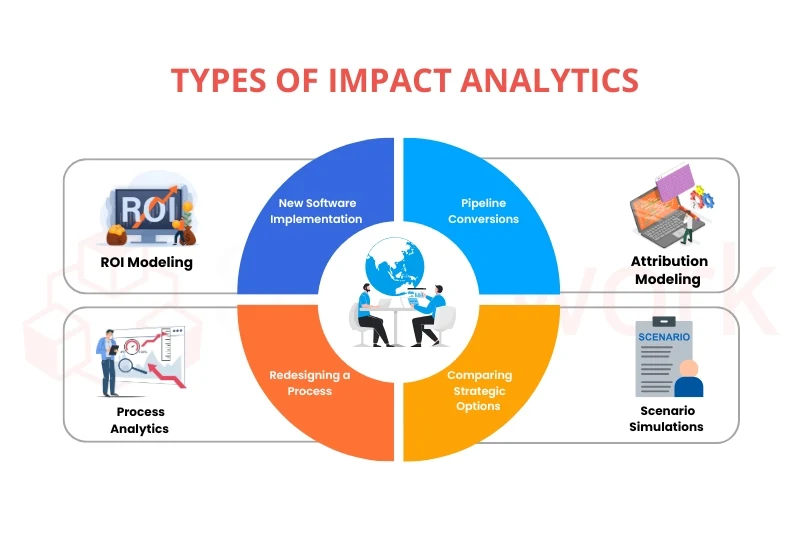
As the data collection methods have extreme influence over the validity of the research outcomes, it is considered as the crucial aspect of the studies
May 2025 | Source: News-Medical

Impact Analytics support B2B companies to demonstrate what’s working and rectify what’s not working. This is crucial for industries like:
Enterprise SaaS – struggling to prove ROI from product upgrades
Consulting Firms – needed to validate outcomes for clients
Industrial Tech – having to justify automation investment
Healthcare & Pharma – assessing cost and outcome of R&D projects
Marketing Agencies – connecting campaigns to pipeline value
When your decisions are based on gut feel, budget and trust are at risk. Impact Analytics connect action to outcome—therefore every decision is based on data, not on assumptions.
Role / Team | Why It Matters |
Marketing leaders | Need well designed white papers and case studies that reflect brand authority. |
Sales Enablement Teams | Proposal professionalism speeds up client decision-making and boosts our win rates. |
Corporate communications | Clean annual reports and newsletters elevate stakeholder credibilty. |
Product / Research Teams | Clear design reports align the internal team and deliver positive outcomes with decision-making |
HR / Training Departments | Effective onboarding materials support better employee outcomes. |
| Obstacles | Definition |
| Misaligned Metrics | Teams focus on vanity metrics that do not relate to business outcomes. |
| Data in Silos | Implementation data and sales, marketing, and finance data exists in silos with no integrative solutions. |
| No Analytics Strategy | Reporting is conducted for ad hoc purposes without attention to business outcome objectives. |
| Analytics Paralysis – Too Many Tools | Too many dashboards with unclear correlations between metrics [2]. |
| Execs Are Unsure of ROI on Analytics Strategy | Executives and leaders dismiss analytical efforts due to distrust and lack of ROI. |
| Skills Gap | Teams are not knowledgeable in training and implementing impact frameworks. |
| Inconsistent Measurement | Variances exist in defining and measuring intangible ROI for a business initiative. |
A SaaS company was tracking app usage—but couldn’t prove if it reduced churn. Product and sales teams blamed each other. Budgets stalled.
Statswork offers customized impact analytics services, including:
Personalized BADIR Framework From business question — to data — to recommendation | Impact Matrix Maps We map all metrics to their business value, and speed to action | Dashboard Integration One vetted view — custom for execs, managers, or analysts |
ROI Modeling We quantify the real value of a strategy, product, or campaign | Scenario Simulation “What if” forecasting to guide better decision making | Ongoing Reviews We track impact over time — not just once |
| ROI Modeling Projected impact of a new software implementation or expansion into a new market | Process Analytics Anticipating the unintended consequences of automating a task or redesigning a process | Attribution Modeling Determining the impact of each channel on pipeline conversions | A/B and Trials Examining how well a feature launch or email campaign performed | Scenario Simulations Comparing strategic options (e.g., pricing or product) |

|
• BADIR Framework (Business ➝ Recommendations) to systematize. |
• Impact Matrix to chart key metrics according to impact/time-to-value. |
• PLS-SEM and Structural Equation Modelling (for linkages to ROI). |
|
• Time-Series & Scenario Simulation (forecasting impact), and |
• Attribution Modelling (to distribute value across touchpoints). |
| Software/Tool | Use Case |
| Power BI / Tableau | Dashboard for mapping metrics by leadership level |
| Excel VBA / Python | Scenario simulation and ROI simulation |
| SPSS / SmartPLS | PLS-SEM modelling for complex impact analysis |
| AWS / Snowflake | Systems integration from siloed systems |
| Mixpanel / Adobe Analytics | Attribution and event frameworks |
Impact analytics relates actions to business outcomes and ROI; BI merely reports what has happened.
Yes—proxy metrics, modelling and refinement—imperfect data can still provide insight.
BADIR provides a systematic, outcome-based method of analytics [3], which ensures businesses will see measurable value.
Quick wins will happen in 4–8 weeks. Strategic impact is usually recognized over a handful of quarters.
Basic frameworks are sufficient, though advanced modelling techniques (e.g., SEM and simulation) can increase the credibility and accuracy of your insights.

Impact Analytics systematically converts data from descriptive reporting into strategic assets. For B2B leaders, Impact Analytics provides opportunities to demonstrate true ROI, incorporate analytics into their strategic objectives and represent accountability as part of an organization. The end result is analytics that produce measurable business-driving impact.
Ready to quantify your impact? Contact us to clarify, quantify and maximize the impact of analytics ROI for your organization.
[Measure Impact Now] or [Chat with Our Expert]

WhatsApp us